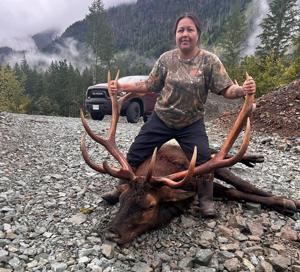Lifestyle
Tseshaht Women Harvest Roosevelt Elk, Strengthen Community Bonds

Vancouver Island, BC – Two members of the Tseshaht First Nation, Leisa Hassall and Sylvia Dick, successfully harvested their first Roosevelt elk this fall, contributing to their community’s sustenance. Hassall, 36, shot a four-by-four bull elk in the Comox Main area on September 27, 2023, while Dick, 38, took down a seven-by-seven Imperial elk in the Taylor Arm area on September 29, 2023.
Hassall expressed gratitude for the experience, stating, “When I harvest animals, I am always thanking the Creator. Being connected to our culture and our traditional prayer is a meaningful way of grounding ourselves.” During her first hunt with her husband, John Morgan Hassall, and brother, Jordan Dick, she felt a deep connection to her heritage, emphasizing the importance of respect for the land and the animals.
After making her shot from a distance of 300 yards, Hassall learned a crucial lesson. “I should have been more careful,” she reflected. “My brother said, ‘Just let him sit,’ but I was too excited.” This experience underscored the importance of patience and respect during hunting.
The Tseshaht First Nation allocates four elk tags each year, with 30 to 40 members entering a lottery for the chance to hunt. The winners keep half of the meat, while the other half is distributed among the approximately 1,267 community members. Dick, who had entered the draw for a decade without success, felt a sense of destiny when she was selected this year. “I had a feeling this year I was going to get picked, and sure enough, I got picked,” she said, recalling the excitement of her successful hunt alongside her spouse, Rick Mack.
Both women view their hunts as not only personal achievements but also as opportunities to provide for their community. Dick elaborated, “As soon as I saw (the band) post that they were handing (the meat out) to the community, it made me really happy that I could do that for my community.” She generously shared her portion with around ten families, illustrating the communal spirit of the hunt.
Hassall shared similar sentiments, stating that her elk would provide her family with traditional food for up to three years, including elk steaks, roasts, and burgers. “It’s so lean. It’s so tender,” she explained, underscoring the nutritional benefits of the meat. The connection to traditional food sources is significant for both women, particularly for Hassall’s children, who have grown up with a strong understanding of where their food comes from.
Reflecting on her upbringing, Hassall described how she and Dick come from families that value hunting and fishing. They would accompany their male relatives on hunts, learning the traditions and skills that have been passed down through generations. “We respect the land,” she emphasized, noting the importance of teaching the next generation about the cultural and environmental responsibilities that come with hunting.
The Roosevelt elk, known as ƛ̓uunim in the Tseshaht language, is Vancouver Island’s largest land animal, with populations currently considered stable to increasing. These elk, named after former U.S. President Theodore Roosevelt, weigh over 1,000 pounds and are primarily found on Vancouver Island and parts of the southwestern mainland. Aerial surveys in 2022 estimated the population at around 5,600 to 6,300.
While the population appears stable, the B.C. Ministry of Forests, Lands and Natural Resource Operations warns that Roosevelt elk remain vulnerable to threats such as unregulated hunting and habitat degradation. “Over-winter mortality during periodic severe winters, which may become more frequent as a result of climate change, can also significantly reduce elk populations,” the ministry noted.
Both Hassall and Dick are eager for future hunts. However, they will need to wait, as Tseshaht regulations prohibit members from winning an elk tag two consecutive years. They hope their experiences will inspire other women in the Nuu-chah-nulth community to engage in hunting, emphasizing the importance of tradition and community involvement in sustainable practices.
Their stories reflect the broader narrative of cultural connection, environmental stewardship, and community support, reinforcing the values of the Tseshaht First Nation and the significance of hunting in their lives.
-

 Science3 months ago
Science3 months agoToyoake City Proposes Daily Two-Hour Smartphone Use Limit
-

 Top Stories3 months ago
Top Stories3 months agoPedestrian Fatally Injured in Esquimalt Collision on August 14
-

 Health3 months ago
Health3 months agoB.C. Review Reveals Urgent Need for Rare-Disease Drug Reforms
-

 Technology3 months ago
Technology3 months agoDark Adventure Game “Bye Sweet Carole” Set for October Release
-

 World3 months ago
World3 months agoJimmy Lai’s Defense Challenges Charges Under National Security Law
-

 Lifestyle3 months ago
Lifestyle3 months agoVictoria’s Pop-Up Shop Shines Light on B.C.’s Wolf Cull
-

 Technology3 months ago
Technology3 months agoKonami Revives Iconic Metal Gear Solid Delta Ahead of Release
-

 Technology3 months ago
Technology3 months agoApple Expands Self-Service Repair Program to Canada
-

 Technology3 months ago
Technology3 months agoSnapmaker U1 Color 3D Printer Redefines Speed and Sustainability
-

 Technology3 months ago
Technology3 months agoAION Folding Knife: Redefining EDC Design with Premium Materials
-

 Business3 months ago
Business3 months agoGordon Murray Automotive Unveils S1 LM and Le Mans GTR at Monterey
-

 Technology3 months ago
Technology3 months agoSolve Today’s Wordle Challenge: Hints and Answer for August 19









